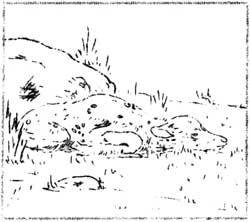SPRING ELK OBSERVATIONS
by
F. R. Oberhansley, Junior Naturalist.
Reviewing some impressions of spring in Yellowstone there is an
intermingling of emotions with certain events. This is a most critical
season in the lives of our wild animals. It truly marks the passing of
the old and the birth of the new.
As spring approaches, large herds of elk follow receding snow banks
over time worn trails from their lower winter range toward the higher
summer feeding grounds. Along these migration trails many animals fall
by the wayside. Weakened by natural infirmities and old age, coupled
with the rigors of a hard winter and limited winter range, their
decaying bodies lend a discordant note to spring. Nature is consistent
and ruthless in weeding out the unfit.
While on a two day trip from the Hellroaring Ranger Station,
following down the slopes of the Yellowstone River, one hundred eight
dead elk (Cervus canadensis canadensis) and thirteen deer (Odocoillus
heminous macrotis) carcasses were counted by the writer and Dr. Adolph
Murie on April 26 and 27. This number is not to be considered large in
view of the many thousands of elk that follow this route. Most of the
surviving animals at this time are rather scrawny in their ragged winter
coats.
One month later the picture has changed. The animals, knee deep in
grass and myriads of flowering plants, become sleek and shiny in their
summer coats. At this time the bulls and cows range in separate
scattered bands. When a lone cow is observed we know that she has a new
born calf nearby or that she has left the band with which she has been
ranging, to give birth to one. If we can watch the cow without being
observed by her, generally she will point out the location of the calf.
Otherwise it would be difficult to find.
There is a popular belief that elk, antelope and other wild mothers
hide their young for several days in one spot until they are able to
follow. Careful study of four newly born elk calves and two antelope
kids shows that in neither case did the mother cache the young in a
given spot. In each case observed, the young animals moved a
considerable distance from where they were born and chose their own
places of concealment. In one case a day old calf was observed to move
twice in one hour without intervention on the part of the mother, a
total distance of more than one hundred yards from the spot where it was
born.

For a time after birth the elk calf is spotted and of a color that
blends in quite perfectly with the background. It has often been said
that while the calf is very young, its odor is not perceptible to any
animal except its mother. This theory is not sound as there is evidence
that predators occasionally find them chiefly by scent. Also their scent
is definitely tangible at close range to human nostrils. It is
definitely a pleasant, sweet, odor, entirely in keeping with the beauty
of the young animal.
The heaviest natural losses in elk seem to be represented by infant
mortality. It is estimated that not more than twelve or fifteen per cent
of the total number of cows bring calves to the yearling stage. The
total number of representative counts made by the writer this spring
show only slightly over ten per cent yearlings.
It is recognized that some of the cows are barren, yet the mortality
seems high. Evidence points to several causes. Undoubtedly many calves
are born dead, or die shortly after being born. Some we know are
premature, and still others are taken by predators. There are
undoubtedly more important factors to be considered, chief among which
is the toll exacted by hunters when the animals drift across the firing
line to the north in the late fall and early winter. Of the calves
observed to date, five dead have been seen, three of which were born
dead or died shortly thereafter while the cause of death in the other
two was not possible to determine.
The very young calves are excellent swimmers. One was observed to
successfully follow its mother across the swollen waters of the
Yellowstone River in Hayden Valley with ease; on the same day, June 6, a
cow and calf were observed on the shore of Yellowstone Lake. Resenting
photographers, the cow waded into the Lake and began swimming toward
Stevenson Island, three and one-half miles away. The calf swam smoothly
in its mother's wake for fifty yards until a motor boat headed her back
to the shore.
The transition from winter to spring has been intensely interesting
and our visitors have never had better opportunities of seeing large
numbers of elk and other wild animals than is afforded at this time in
all parts of the Park.

